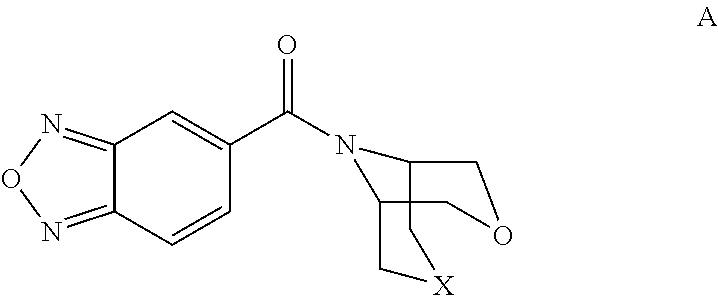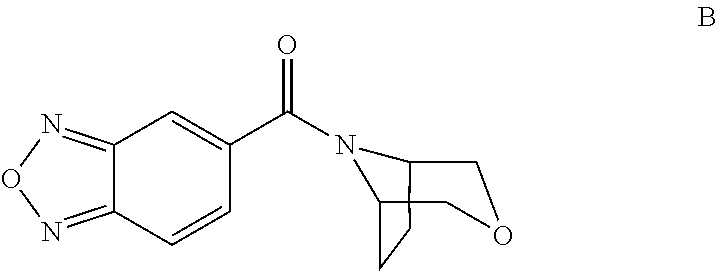Bicyclic amide derivatives for enhancing glutamatergic synaptic responses
a glutamatergic synaptic and derivative technology, applied in the field of bicyclic amide derivatives for enhancing glutamatergic synaptic responses, can solve problems such as schizophrenia or schizophreniform behavior, and achieve the effects of increasing the amplitude of the field, stabilizing the baseline of evoked responses, and increasing the field amplitud
- Summary
- Abstract
- Description
- Claims
- Application Information
AI Technical Summary
Benefits of technology
Problems solved by technology
Method used
Image
Examples
example 1
[2,1,3]-Benzoxadiazol-5-yl(3-oxa-8-azabicyclo[3.2.1]oct-8-yl)methanone
[0076]
[0077]Cis-1-Benzyl-2,5-(dihydroxymethyl)pyrrolidine hydrochloride (3.0 g, 13.5 mmol, see: U.S. Pat. No. 7,012,074) was dissolved in concentrated H2SO4 (10 ml) and heated to 120° C. for 9 hours. The cooled solution was basified with 10N NaOH (to pH 10) and extracted with ethyl acetate (2×100 ml). The organic phase was dried over sodium sulfate, and concentrated under vacuum to yield 1.5 g of a colorless oil. The preceding product was dissolved in dichloromethane (50 ml) and methanol (50 ml), and 10% Pd / C (0.5 g) was added. The mixture was hydrogenated at 60 psi over night. The solids were filtered off, a solution of HCl in dioxane (2 ml, 4N) was added and the solvent evaporated. The residue was dissolved in dichloromethane (100 ml) and triethylamine (3 ml) and a solution of [2,1,3]-benzoxadiazole-5-carbonylchloride (1.27 g, 7 mmol) in dichloromethane (10 ml) was added. After stirring the mixture for 0.3 h, wa...
example 2
[2,1,3]-Benzoxadiazol-5-yl(3-oxa-9-azabicyclo[3.3.1]non-9-yl)methanone
[0078]
[0079]9-Benzyl-3-oxa-9-azabicyclo-(3.3.1)nonane (3.0 g, 13.8 mmol, see: WO 03004503) was dissolved in ethanol (100 ml), and 10% Pd / C (0.56 g) was added. The mixture was hydrogenated at 100 psi over night. The solids were filtered off, a solution of HCl in dioxane (4 ml, 4N) was added and the solvent evaporated. The residue was dissolved in dichloromethane (100 ml) and triethylamine (8 ml) and a solution of [2,1,3]-benzoxadiazole-5-carbonylchloride (3.5 g, 19.2 mmol) in dichloromethane (10 ml) was added. After stirring the mixture for 20 minutes, water (100 ml) and H2SO4 (→pH2) were added and the organic phase washed with sodium bicarbonate solution (100 ml), the aqueous was re-extracted with dichloromethane (100 ml) and the combined organic phase was dried over magnesium sulfate, and concentrated under vacuum. The crude material was purified by silica gel chromatography eluting with hexane / THF (70 / 30). The p...
example 3
[2,1,3]-Benzoxadiazol-5-yl(3,7-dioxa-9-azabicyclo[3.3.1]non-9-yl)methanone
[0080]
[0081]9-Benzyl-3,7-dioxa-9-azabicyclo-(3.3.1)nonane (650 mg, 2.96 mmol, see: JOC, Vol. 71, No. 1, 2006, 413-415) was dissolved in methanol (20 ml) and formic acid (4 ml). 10% Pd / C (0.3 g) was added and the mixture was hydrogenated over night. The solids were filtered off, and the solvent evaporated. The residue was dissolved in methanol (20 ml) and a solution of HCl in dioxane (2 ml, 4N) was added and the solvent evaporated. The residue was dissolved in dichloromethane (80 ml), THF (20 ml) and triethylamine (3 ml) and a solution of [2,1,3]-benzoxadiazole-5-carbonylchloride (1.0 g, 5.5 mmol) in dichloromethane (10 ml) was added. After stirring the mixture for 0.5 h, water (100 ml) and H2SO4 (→pH2) were added and the organic phase extracted with sodium bicarbonate solution (100 ml), the aqueous was re-extracted with dichloromethane (50 ml) and the combined organics were dried over magnesium sulfate, and co...
PUM
| Property | Measurement | Unit |
|---|---|---|
| temperature | aaaaa | aaaaa |
| temperature | aaaaa | aaaaa |
| pH | aaaaa | aaaaa |
Abstract
Description
Claims
Application Information
 Login to View More
Login to View More - R&D
- Intellectual Property
- Life Sciences
- Materials
- Tech Scout
- Unparalleled Data Quality
- Higher Quality Content
- 60% Fewer Hallucinations
Browse by: Latest US Patents, China's latest patents, Technical Efficacy Thesaurus, Application Domain, Technology Topic, Popular Technical Reports.
© 2025 PatSnap. All rights reserved.Legal|Privacy policy|Modern Slavery Act Transparency Statement|Sitemap|About US| Contact US: help@patsnap.com



